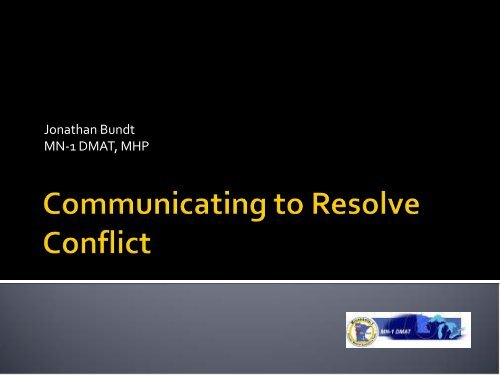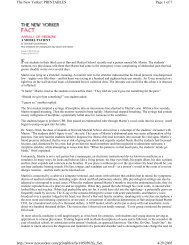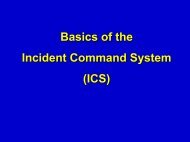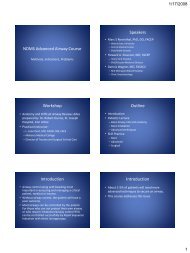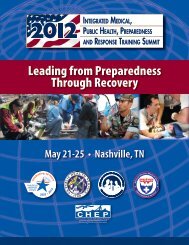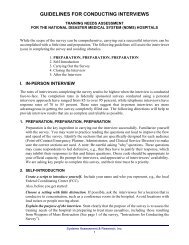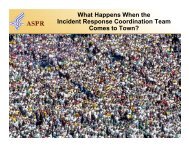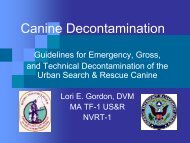Jonathan Bundt MN-1 DMAT, MHP
Jonathan Bundt MN-1 DMAT, MHP
Jonathan Bundt MN-1 DMAT, MHP
- No tags were found...
You also want an ePaper? Increase the reach of your titles
YUMPU automatically turns print PDFs into web optimized ePapers that Google loves.
<strong>Jonathan</strong> <strong>Bundt</strong><strong>MN</strong>-1 <strong>DMAT</strong>, <strong>MHP</strong>
• Discuss the relationship between conflict anddisaster response.• Explain best practices in mitigatinginterpersonal conflict.• Identify rapid communication strategies thatwill assist in conflict resolution amongst teammembers.
Personalities will clash, badtempers flare up, goals not beingachieved and disputes arise.However with strong leadership,clear direction, and resolutionprocesses in place, conflict canbe minimized and turned toopportunities.
• Your reactions• Thoughts, Feelings,Behaviors, Physical• Deploymentspecific stressors• Having a plan ornot
• Leader as a mediator• Role of emotion• Getting needs meet• Does cultural have anything to do with it• Turf, Resources, Rewards, Functions, honestdifference of opinion
• All behavior is goaldirected• Understanding thegoals
• Be in control• Be right• Not make waves• Have the answers• Keep the peace• Be the expert• Help others
• Amount of power involved• Difficult behaviors• Positive behaviors• How I experience(thoughts and feelings)• My response to thebehaviors• What influenced me• What will I do different
• Aggressor: persistentto bullying• Passive: evasive andambiguous• Passive-Aggressive:indirect style
• Prior relationships• Lack of priorrelationships• Concept ofproblem ownership
• Being rational, goal directed, producesubstantive demands, and require theassistance of an outside party• Having clear expectations• Helping team members save face
• Having an accurateoperational definitionis the first step indeveloping strategiesand tactics foreffectively resolvingconflict.• Remove ambiguityand taking anauthoritative stance
• Ability to understand• Be in the others shoe• Achieve the desired effect• Surrender, unharmed• Ethical• Develop trust and respect• Personal level• Concern, caring,interested
InfluenceConnectRapportEmpathyListening
• Tone speaks louder than words and indicatesyour attitude; a calm, controlled demeanor isalways more effective than a brilliant argument.(McMains & Mullins, 2006; Lanceley 2003;Strentz, 2006; Vecchi, 2003, 2004):• Listen to the person• Acknowledge his or her point of view• Agree wherever you can without conceding your ownvalues or morals (find common ground)• Create a positive atmosphere for problem-solving• Don't argue
• Non-verbal stylescan increase ordecrease conflict• Reminder of howwe communicate• Body language
• Don’t react- Be a nonemotional observer• Slow down the processand refocus• Use pauses instead ofresponding immediately.• Slow the pace of theconversation to reduceemotions (Could you slowdown a little?").
• Rephrase what the person just said in nonemotionalterms.• Take a time out.• Step to their side• Find areas of agreement• See them as a person• Not “either/or” but “both/and”
• Treat as a real person and acknowledge hisor her concerns or views.• Search for areas of agreement beyond theinstant situation (sports, movies, etc.).• Use words of familiarity (subject's firstname, insisting the subject use thenegotiator's first name, slang,contractions, etc.).• Obtain compliance without being forcefulor confronting.
• Principled negotiation is a problem-solving-basedapproach that advocates four fundamental principlesto negotiation: 1) separating the people from theproblem; 2) focusing on interests, not positions; 3)inventing options for mutual gain; and 4) insisting onobjective criteria. Unlike positional bargaining,principled negotiation gives ownership of theoutcome of the negotiation to all the stakeholders.This approach to negotiation speaks to content- andsubstantive-focused high conflict situationsFisher, Ury, & Patton (2001).
• It is important to note that people don't alwayssay what they mean, so it is important toattempt to listen for the meaning behind thewords in order to reveal the needs of the person• Security needs (physical/emotional)• Recognition needs (person's view is understoodand acknowledged)• Control needs (ownership in the process, havingsome say in the matter)• Dignity needs (saving face)• Accomplishment needs (achieving something)
• Conflict avoidance• Without managementintervention the conflict canreadily approach crisis point.• There may be strong clashes,highly emotional outbursts, shockresignations, verbal abuse, eventhreats of physical violence.
• Call it scuttle, watercooler talk, Grapevine• Dealing with the issueand taking it seriously• Key is timing andaccuracy
• Stay calm and in control – your calmness will help• Request respect and cooperation• Encourage discussion by using open-endedquestions• Allow them to be silent for a while if necessary, bepatient• Rephrase difficult questions• Does the person prefer to speak in
• Leaders must get involved as early aspossible and attempt to diffuse and resolvethe dispute to the satisfaction of both parties.Initially leaders need to bring both partiestogether and discuss the situation. A possibledispute resolution process could be:
• Identify parties involved• Set ground rules• Each person will take a turn to present theirside• Identify challenges• Resolution
• Ignoring• “We always do it that way.”• Groupthink, not allowing for open dialogue• Not making a decision• Lack of use of command decision making
• Cumulative Deployment Stress• Traumatic Deployment Stress
• Doesn’t exist; leadsto conflict build up• Based on sharedexpectation• Asking open endedquestions
• How do you address conflict in teams?• To team development, training?• To team response?
• Glass Balls: lead, train, maintain, care• Lead by example• Identify with your people• Mistakes will happen• Effective leaders:• Blond vs. Arbiviv
Hit it head on,manage it!!
5100 Eden Ave Ste 319, Minneapolis, <strong>MN</strong> 55426952-922-0422<strong>Jonathan</strong>@masaconsulting.com


